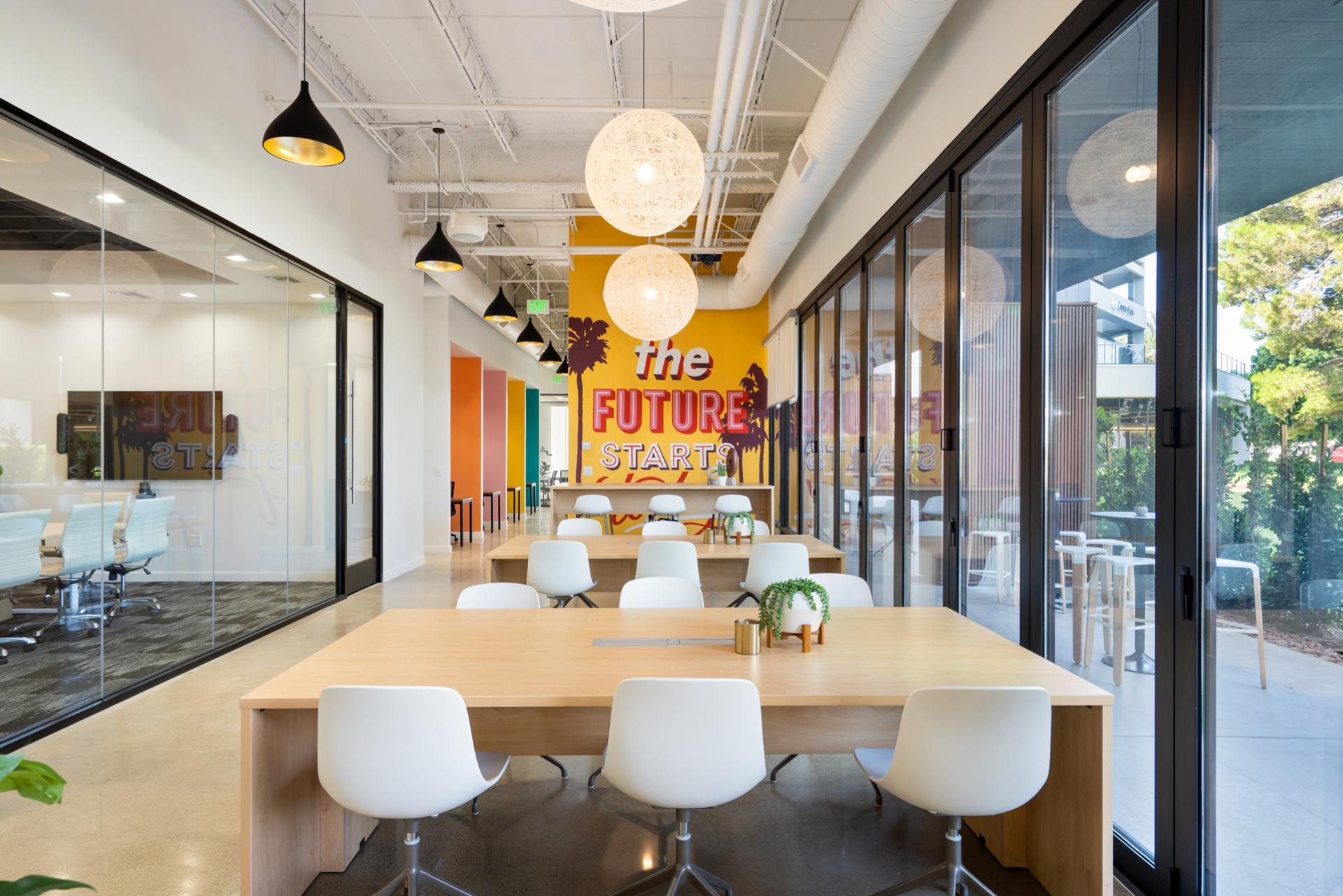Back in March 2021, Microsoft declared that “the future of work is here and it’s hybrid,” predicting that the hybrid office will become the new normal for most companies.
Data from 2022 backs this up, with 77% of respondents in JLL’s annual survey agreeing that remote or hybrid work will be key for talent attraction and retention in the coming years. And what’s more is that 43% of them plan to invest in flexible workspace to make that happen.
And Microsoft’s not the only large company embracing this trend.
Many notable companies including Target, Apple, Adobe, Google, and Citigroup are all now operating as hybrid offices.
In this article, we’ll explore the benefits and challenges of a hybrid office, how you can set one up, and why a flexible workspace might be the best home for your hybrid team.
What Exactly is the Meaning of Hybrid Work?
While it might be a familiar term to some, the meaning of hybrid work may be less clear to others, and that lack of familiarity may be inhibitive when it comes to using it for the benefit of their business.
Hybrid work is when employees are able to work from multiple locations, most often part-time at their home office and part-time at a company office or workspace.
After the pandemic forced much of the workforce to work from home for health and safety reasons, employees started enjoying benefits such as greater flexibility and more personal time.
But remote work wasn’t just beneficial from a personal perspective: employees also became better able to manage their workdays based on where and how they work best.
Once health concerns surrounding COVID-19 began to wane, many employers had a hard time convincing employees to come back to the office and resume “business as usual.”
Many compromised with a hybrid arrangement in which employees were able to spend part of the week working remotely, and part of the week working in the office.
And many more are beginning to embrace the idea as a viable option to improve employee engagement and morale and reduce the overhead costs associated with running an office.
The Main Benefits of Hybrid Work for Employees and Businesses
As it turns out, the hybrid work model has become increasingly popular. McKinsey found that 85% of employees who are operating on a hybrid work schedule want to keep it.
And it’s easy to see why—the benefits are plentiful.
They include:
- More flexibility throughout the week
- Increased performance because of the option to work where they’re most productive
- Connection and community with colleagues
- Autonomy over work schedule and tasks
And employers also stand to benefit from hybrid work through:
- Higher employee satisfaction which, in turn, improves retention, recruitment of top talent, and performance among existing employees
- The opportunity to reduce overhead costs by downsizing their office to accommodate smaller in-office teams
- The ability to tap into a broader talent pool who are unconfined by geographical constraints
The Current Challenges with Hybrid Work
Given that hybrid work is still a relatively new concept, it’s still susceptible to challenges, especially while businesses figure out how to properly implement hybrid work schedules and hybrid work policies.
Specifically, the greatest current challenges with hybrid work include:
- Creating a consistent and fair hybrid work policy that equally benefits all employees
- Maintaining a work schedule and desk-sharing arrangement that supports the operations of the company as well as employee preferences
- Maintaining company culture, corporate identity, and interpersonal relationships between staff with limited facetime
But like any operational hurdles in business, these challenges can be addressed with careful planning.
Key Features of a Hybrid Office
Since hybrid work requires a workspace that employees can attend on an as-needed basis, setting up a hybrid office is critical to the success of the concept.
There are a number of options available for hybrid offices, including:
- Traditional office space: Though it’s shifting rapidly, this was once the norm for most companies—leased office space to accommodate a full team of employees. In the hybrid work world, these workspaces can be transformed into hybrid offices where employees can come in when and how they need. In this instance, though, many companies will find themselves paying for an office space that only has 50% attendance on any given day.
- Flexible workspaces: A private office in a coworking space is a flexible option for companies embracing hybrid work. Because of their available short lease terms and flexible options, businesses can scale their space up and down as needed. This also allows them to only take on the physical footprint they need for a portion of their team while still having access to the full suite of amenities offered by traditional office spaces, like meeting rooms, phone booths, lounge areas, and all necessary hardware and professional tools.
- Coworking: Hybrid office can operate by simply offering a hot desk coworking membership or getting a predetermined number of dedicated desks for individual team members to use as they wish. This way, employees have autonomy over where they want to work throughout the week.
A hybrid office can take on many forms, but it’s not just the physical space that matters so much—it’s the purpose and intent of it.
A hybrid office is a purpose-driven space for your team. It’s a gathering place for:
- Scheduled team meetings and collaboration: You can take advantage of bookable meeting rooms in a coworking space, for example.
- Casual and impromptu “water cooler” talk: This can only happen when employees are in the same space. It forms positive connections between team members that drive performance.
- Productivity and focus through spatial diversity: Flexible workplaces like Colab Space offer a variety of areas for employees to choose from—lounge, outdoor area, kitchen, private office, and more.
How to Set Up a Hybrid Office
A hybrid office has the potential to boost productivity, bolster employee well-being, and foster important connections.
But, it takes some logistics planning to get right. Here are three major areas you need to focus on to set up a hybrid office:
1. Hybrid Work Policy
Start by creating a hybrid work policy. The purpose is to create something that’s both clear and equitable, so all team members are on the same page.
Some things to consider include:
- Position Eligibility: Who is able to work on a hybrid schedule and who cannot. Based on their position (i.e., customer service representative), some employees may not be able to work from home at all.
- Work schedule: Include details about how the hybrid schedule will work (more on that below).
- Reporting and accountability: Does this plan shift reporting structures at all?
- Protocols: Include details about how to book office space, if needed, and other logistics.
- Time horizon: Do you plan to operate a hybrid office for just a short-term trial, or is this the way it will be moving forward. Include details about potential re-evaluation in the future, as needed.
2. Hybrid Work Schedule
The biggest part of your hybrid work policy will be the schedule—who’s working where and when.
There are three hybrid work schedule models to choose from:
- Set schedule model: This is when employers set specific parameters for when employees are in the office. For example, they may be three days at home, two in the office. Team members may be split into cohorts that rotate or are in the office for the same days.
- Semi-flexible model: This type of hybrid work schedule allows employees to choose the days they want to come into work based on a company minimum (i.e., they must be there two days per week, but which days are up to them).
- Total-flexibility model: Here, employees can work where they want, when they want. That might be 100% remote or 100% in the office, just depending on what they choose.
Each option has its pros and cons, but you need to consider the balance between employee flexibility and operational needs.
3. Hybrid Office Setup
Based on your hybrid work policy and schedule, you can then think about the logistics for your hybrid office setup. Start by thinking about workplace needs:
- Meeting rooms: To support in-person collaboration, you need access to private conference rooms or event spaces for your team to gather.
- Location: Consider proximity to where your employees live, transit access, and nearby services like restaurants or gyms.
- Services and amenities: Practical items like high-speed internet, printing and scanning services, or on-site support can make your remote office run smoothly.
- Workspaces: Think about where employees will work each day. If there are shared desks, consider if they need to be booked in advance or if it’s first-come-first-serve. Opting for a coworking space with a variety of options is a simple way to navigate this area.
- Tools and technology: A downside of working from home is the lack of access to necessary tools and equipment. Make sure that your hybrid office, then, has everything your team needs to do their work.
Flexibility is key for hybrid offices. It allows you to scale up or down as needed and allows you to try different models and options to see what works best.
For this reason, flexible workspaces have the upper hand over traditional offices when it comes to hybrid work. Without long-term commitments and strict contracts, you can create the perfect hybrid office space for your team without breaking the bank.
If you’re looking for a workspace for your hybrid team in Orange County, book a tour of The Colab Space today.


